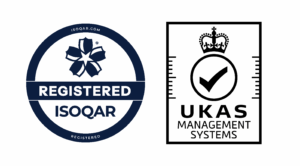Chatbots: The Essential Guide
Learn everything you need to know about chatbots, how they work, the benefits of using chatbots in business, how to deploy them and what the future hold for chatbots.
What Is a Chatbot?
A chatbot is an online software application that harnesses Artificial Intelligence (AI) and Natural Language Processing (NLP) to solve customer queries and enhance customer experience. Adopted by businesses who wish to optimise their customer service offering and grow new revenue streams, chatbots can engage in conversations and respond to questions similarly to how a live chat agent would.
Whilst chatbot software has been around for decades, it was the introduction of Facebook and Google’s AI-powered bots that catalysed the mainstream adoption of chatbot software for customer service in recent years. Since then, a multitude of companies have reaped the benefits of chatbots, including:
- Operational efficiency
- Financial savings
- Enhanced customer experience
- Increased CSAT scores
Chatbots are deployed on company websites for the facilitation of customer support and due to their success, have become a core tool in any support team from Retail to Finance and Utilities to Telecoms. Chatbots should be built to suit the requirements of the individual company, be those strictly informative, transactional or advisory.
For more on customer service chatbots, click here.
How Do Chatbots Work?
The size of the global chatbot market is growing at an accelerated rate and is expected to reach $9.4 billion by 2024 – a compound annual growth rate of 29.7%. As the chatbot market grows so does its diversity, offering a range of different types and standards of chatbots, for instance:
- Basic, rule-based chatbots: based on simple FAQ systems, this type of chatbot relies on pre-loaded responses that will only trigger when specific keywords or queries are entered by the user. The most common answer these chatbots serve is “I don’t understand the question”.
- AI-powered chatbots: using multi-layered algorithmic Natural Language Understanding (NLU), these chatbots understand customer intent and respond conversationally using Natural Language Generation (NLG). This approach will deliver the right response, regardless of how a query is phrased.
Effective chatbots adopt the latter approach.
Basic, rule-based chatbot

AI-powered chatbot
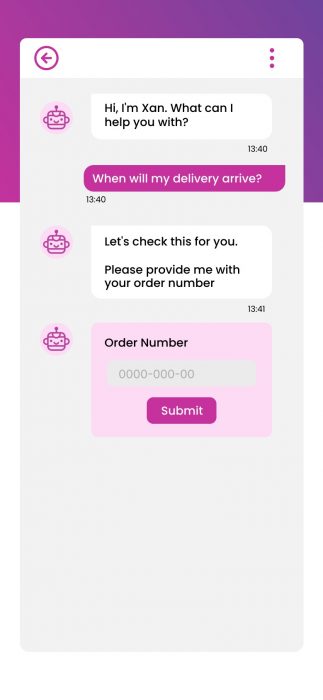
Built-in Machine Learning helps to improve the NLP capabilities of chatbots over time. As a result, the customer simply asks their question in whichever manner they wish, and the NLP algorithms analyse the question in its totality, consulting a company’s centralised knowledge base to determine the most relevant information, then responds conversationally. If the query entered is not explicitly clear or the chatbot is not sure on which answer to give, subsequent questions will be asked to help the chatbot determine what the customer requires and thus the intended result. This result will then be stored for future interactions.
Chatbots in customer service also have the capability to transfer the customer to an alternative contact channel where an agent can intervene if an adequate result cannot be found. Generally, when effective knowledge management is practiced, chatbot software will have the ability to solve all routine questions and the only reason for escalating a customer to an agent is if their issue is too complex or subjective. You will always have non-standard or new questions that a chatbot will have to escalate to a live agent – chatbots are not a panacea.
Whilst chatbots do not claim to be human, they can take on the role of a support agent. They can respond in a conversational manner, learn from interactions and even remember and store information. Customers enjoy the concierge factor that chatbots bring, whilst benefitting from the efficiency and convenience of using an online contact channel.
For more on the benefits of conversational chatbots, click here.
Intelligent chatbot systems cans streamline processes further using trigger management. This allows companies to configure keywords to trigger certain actions when typed. For instance, the keyword “renew” or “cancel” might be set up to trigger a new channel escalation, putting the customer in touch with a human. This helps companies deal with renewals and cancellations promptly whilst encouraging upselling and avoiding customer churn.
Interested in the evolution of AI chatbots? Click here for a brief history.
What Are the Benefits of
Using Chatbots In Business?
Chatbots are more than a fun tool to engage with, when it comes to customer service, they play a crucial role in a company’s overall offering, slotting in perfectly amongst other contact channels. Here’s how the implementation of chatbots can benefit your operations, bottom line, customers and employees.
Chatbots Resolve Mass Queries at Scale
The vast majority of queries you receive are extremely simple issues that customers could resolve in seconds if they had access to your company’s basic information. Without a chatbot to engage with, a customer who has a routine question will interact with an agent assisted channel such as live chat, telephone or email. Such channels involve an accumulation of operational costs including additional staffing costs and overhead costs for contact centres. These costs are avoided by including a chatbot solution in a company’s customer service offering, eliminating the ‘backlog’ that occurs when ticket volumes outpace agent bandwidth.
Companies must also consider the opportunity costs that are accumulated when telephone, email and live chat channels are unnecessarily used. The more time that customers are left waiting on hold or being transferred, the less time they are spending purchasing products and services. These long wait times usually contribute to poor CSAT scores which result in less future revenue, causing a decrease in company’s average lifetime value per customer.
Additionally, because AI takes care of all chatbot conversations, there are no time constraints involved and therefore no limit to how many simultaneous chats can be answered. This allows queries to be solved at scale and promote operational efficiency – it is even predicted that chatbots will save business $8billion by 2022. Not only this but Healthcare and Banking providers using bots could see savings of over 4 minutes per enquiry – the equivalent of $0.50-$0.70 per interaction, according to a Deloitte report.
For more on how contact centres are utilising chatbots, click here.
Chatbots Give Instant, Real-Time Answers for Customer Convenience
There is nothing more frustrating than needing answers to a question when a contact centre is closed. But what if your customers find themselves in an emergency situation whereby they need an issue solving instantaneously and out of hours? This is where chatbot tools can prove invaluable.
According to a recent study, the top benefits of chatbots according to customers were 24-hour service (64%) and getting and instant response (55%). The same study revealed that the top use for a chatbot included getting a quick answer in an emergency situation.
One of the benefits of AI is that it doesn’t need to take breaks, it can handle questions 24 hours, 7 days a week. Answers are therefore produced in real-time and this is an aspect that your customers appreciate, particularly if they find themselves requiring help quickly and during unusual hours. For example, if a customer asked “need emergency plumbing number” at 2AM, the chatbot would be able to provide the knowledge article containing contact details for an approved, out of hours plumber, ultimately preventing a serious situation. Returning visitors then know there is an effective self-service option that runs 24/7, reducing the likelihood of them contacting your contact centre during peak times in the future.
Chatbots Deliver Smooth Customer Journeys
When it comes to serving customers through online channels, it’s not always as simple as: a question is asked, the resolution is given. This scenario assumes that the customer has done all the problem solving prior to the engagement and therefore is aware of the resolution they require. But this isn’t how customer service works, generally a series of follow up questions will be asked to understand the problem further, gaging context and eventually serving the adequate result.
When there is not an agent to ask these questions, chatbots use decision tree technology to guide the customer to where they need to be. Companies carefully configure customer journeys taking into consideration keywords that trigger a set of qualifying questions that, depending on the responses given, will activate a path leading to the resolution. Decision trees can also be configured to identify when it might be best for an agent to intervene with a query and can seamlessly escalate the contact to a live chat channel where they can be helped further. Not only do decision trees help customers find the answers they need, but they create a smooth journey that improves their overall customer experience.
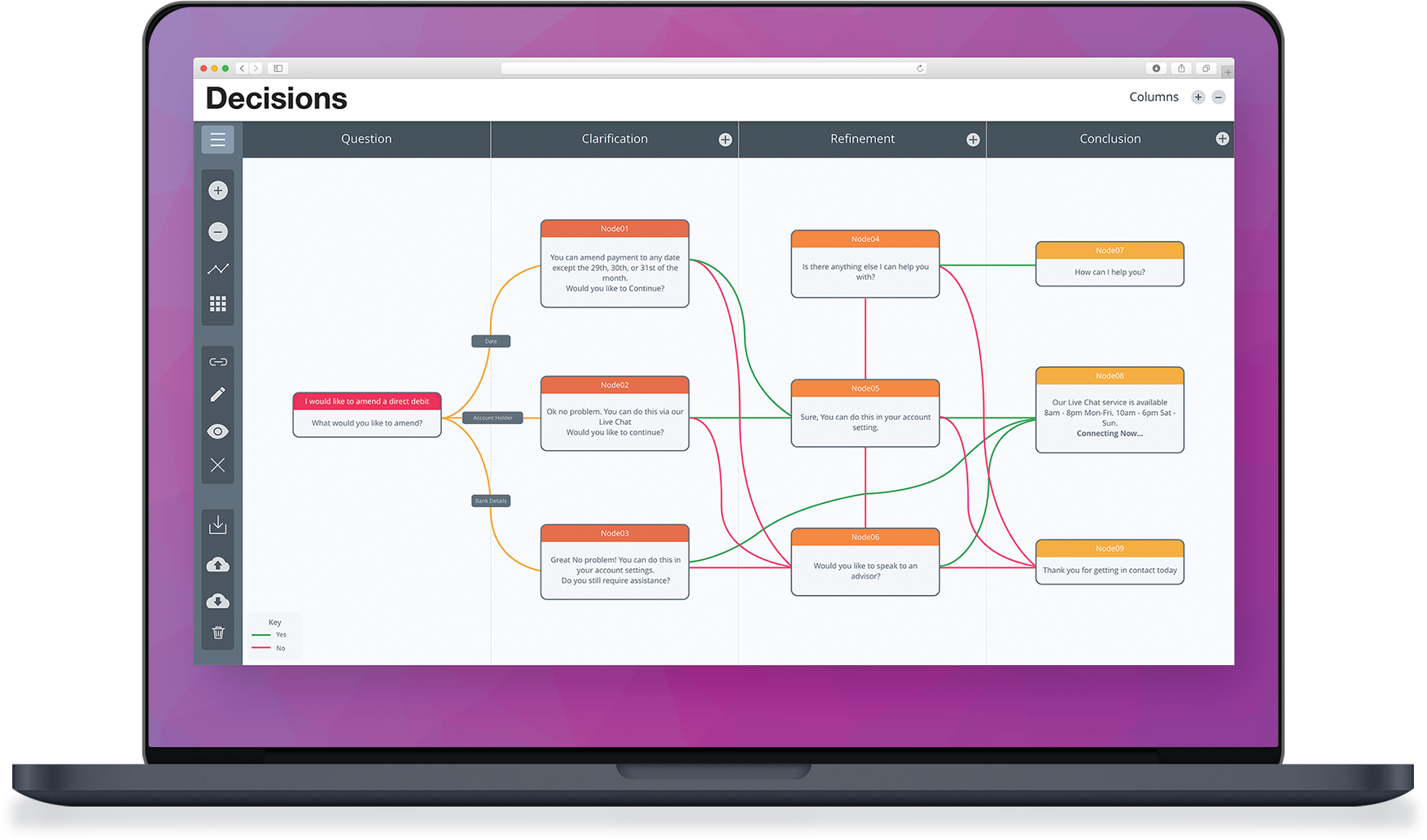
Chatbots Personify Your Brand
Let your chatbot be your brand mascot. When customers land on your site, it is one of the first things they will see and engage with, so ensure that it personifies everything that your company represents.
Effective chatbot software is fully customisable and can be configured to match brand personality, tone of voice, company values and aesthetic. Companies can customise the font, style, layout and logo to match their brand guidelines and even adjust the bot’s language, tone of voice and response style to fit the brand’s character. Quirks and idiosyncrasies can be added to the chatbot’s vocabulary to build credibility and familiarity. This is an effective branding opportunity that carries no additional costs whilst contributing to a great customer experience.
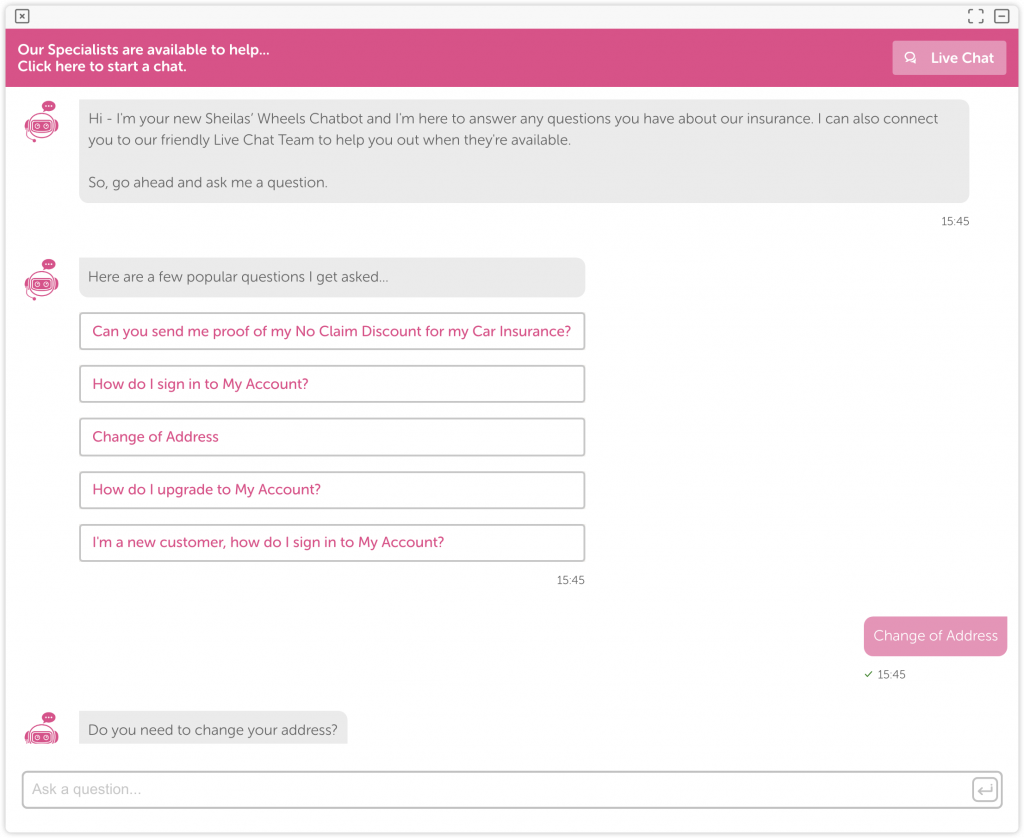
Chatbots Attribute to Lead Generation Activities
The inclusion of chatbots in a customer service offering can contribute to a direct increase in revenue. Acting as a lead generation tool, a chatbot has the capability to qualify leads before passing them on to agents for further assistance.
The chatbot can store intel on the prospect including the questions they have asked, the preferences they have selected and using data capture functions, their contact details. The conversation can then be instantly escalated to an agent or can be picked up when there is one available.
Many potential leads for your business interact with your site with no active CTAs to move them into your sales funnel. Chatbot’s NLP enables them to identify potential ‘hot leads’ where you would previously have no intelligence about this potential customer.
Chatbot’s lead generation qualities also contribute to the reduction of significant operational costs. Because the qualification process is automated it means less agent time is used therefore cutting overheads and freeing up time that can be spent nurturing leads.
Chatbots Utilise NLP To Improve CSAT Scores
Good chatbot software utilises NLP to grasp what the customer needs and delivers the best result based on this. NLP is able to understand naturally phrased questions by taking the contact query, analysing it for search intent, keywords, grammar, and popularity to produce the most relevant response.
If the query intent is not clear, some chatbot solutions will use additional search layers to understand at least the sentence structure and even the context of the query. For example, Synthetix utilises a system called “Jabberwocky” to unpick sentences and analyse a range of word classes to identify conversational responses based on proprietary NLG. You can also manually edit and configure these responses. The purpose of these complimentary search layers is to add personality, increase accuracy and ensure the customer always receives a conversational response, not simply “I’m sorry, I don’t understand the question”. As this strategy avoids many of the failure states of modern chatbots, is has improved CSAT scores for many companies.
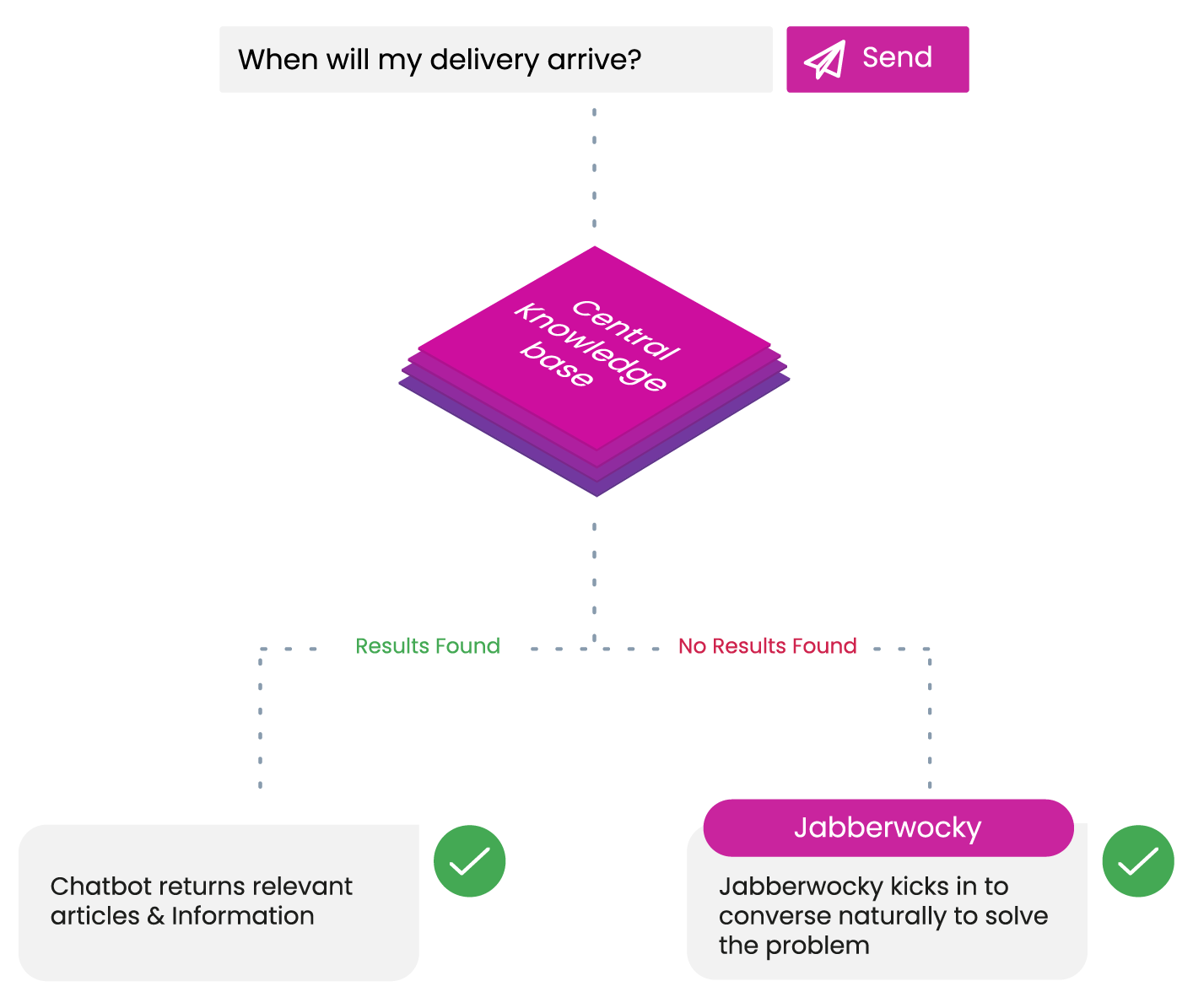
Chatbots Learn from Interactions to Improve CX
Every customer interaction is valuable to a chatbot and its ‘development’. Each keyword that is used, preference that is selected, grammar that is included and idiosyncrasy that is mentioned are important intel for chatbots and key to their learning.
Through Machine Learning, chatbots can identify trends in customer language and behavioural patterns, these can be saved into the system and stored for future interactions for the benefit of other customers. Not only can chatbots continuously improve the way they communicate and answer questions, but their ability to learn makes for an augmented customer experience.
Chatbots Automate Routine Questions and Improve Employee Morale
Chatbot tools that can automate routine queries proving beneficial for both customers and agents. The contact channel allows customers to answer their questions quickly and conveniently without the stress of having to wait in a queue to speak to an agent. With retail businesses losing 75% of customer because of long waiting times , this solution can significantly improve customer churn rate.
Chatbots can benefit agents’ roles too. The automation of routine queries means that employees have a greater capacity to deal with customer queries that are complex and require specialised attention. This makes agents’ jobs more interesting, eliminating the mundane and repetition that comes with routine queries which has a positive impact of staff attrition rates.
Chatbots Escalate to Agent Assisted Channels If Necessary
Not every query can be dealt with using AI, nor will it always be obvious to the customer which contact channel to use. The key here is to offer the right escalation points at the right time during the customer journey.
If the chatbot suspects that it cannot deliver an adequate answer, or a keyword is used that is perhaps sensitive, like “refund”, it will transfer the customer on to an agent who can help further. This escalation works particularly well between chatbot and live chat channels because of their similar layouts.
Contact escalation is important not only for avoiding disgruntled customers and improving CSAT scores, but it presents an opportunity for upselling and revenue contribution when placed correctly.
Read: 6 Advantages of Chatbots in Customer Service HereDeveloping Your Chatbot
Deploying chatbot software shouldn’t be a complex or daunting process. Providing that the correct people are involved, effective technology is selected and a solidified plan is followed, chatbot development can be straightforward. Here’s how.
Centralise Knowledge
The fundamental first step of chatbot development involves the knowledge that will be served to your customers. Companies must begin the process by identifying what knowledge already exists and is documented internally. This usually involves explicit knowledge which is simple to communicate such as guides, report and manuals and can be discovered using data mining and looking through company intranets and shared platforms.
Companies then move on to extracting tacit company knowledge. This is the type of knowledge that has been accumulated over many years, residing in the brains of senior employees. Tacit knowledge is based on experience, skill and perspective, it is deep rooted and therefore proves difficult to interpret and share. To overcome this, companies use a range of knowledge acquisition techniques, including:
- Interviews
- Retrospect
- Knowledge Harvesting
Once captured, it is good practice to store all knowledge, both explicit and tacit, in one centralised spreadsheet. Knowledge can then be collated and refine into consumable articles, often rewritten to match a consistent tone of voice. Your chatbot software vendor can later handle the bulk importation of knowledge into your knowledge base which seamlessly integrates with your chatbot tool.
Set Chatbot Goals
Before deploying your chatbot, it is important to set SMART objectives so that the tool’s effectiveness can be measured over time. Begin by gathering input from a range of employees who are involved in the process – gage what they expect from the chatbot in terms of success, output and return on investment – this will help shape the objectives and subsequent goals.
Having taken organisational needs into consideration, a set of ‘chatbot KPIs’ are generated and then monitored similar to how employee KPIs are – these generally surround:
- Operational efficiency
- Reduced overheads
- Customer satisfaction
- Customer experience
Frequently referring to these goals helps to judge if you are on track, monitoring progress and determining any adjustments that are necessary along the way. This also provides employees with a long-term vision regarding customer service and chatbots, giving them something to work towards.
Know your Customer Journey
Understanding your customer journey is critical to the success of your chatbot. It doesn’t matter how good a chatbot is, if customers can’t find it then it benefits no one and is ultimately a waste of resource. The customer journey must be at the forefront of deployment, attaching the chatbot to key points in the customer journey for effectiveness and visibility.
To understand your customer journey, you must start with customer metrics that relate to online behaviours and preferences. Such metrics can give away clues as to where chatbots will be best included, for example:
- Site analytics like bounce rates, time spent on page, exit pages, conversion pages and cart abandonment rates reveal invisible pain points that can be resolved by the inclusion of a chatbot.
- Heatmap technology uncovers hidden issues or opportunities that can be utilised with a chatbot.
- User testing and surveys explicitly tells you what is frustrating with the current customer journey and how it could be improved, including where a chatbot should be introduced.
Once customer journeys are mapped out, you can easily cater to them. Use trigger management to decide when, on which page and how a chatbot should be displayed – this is all based on customer preferences. Companies can even configure the look and feel of a chatbot to fit the customer’s needs whether its tone of voice, grammar used or aesthetic.
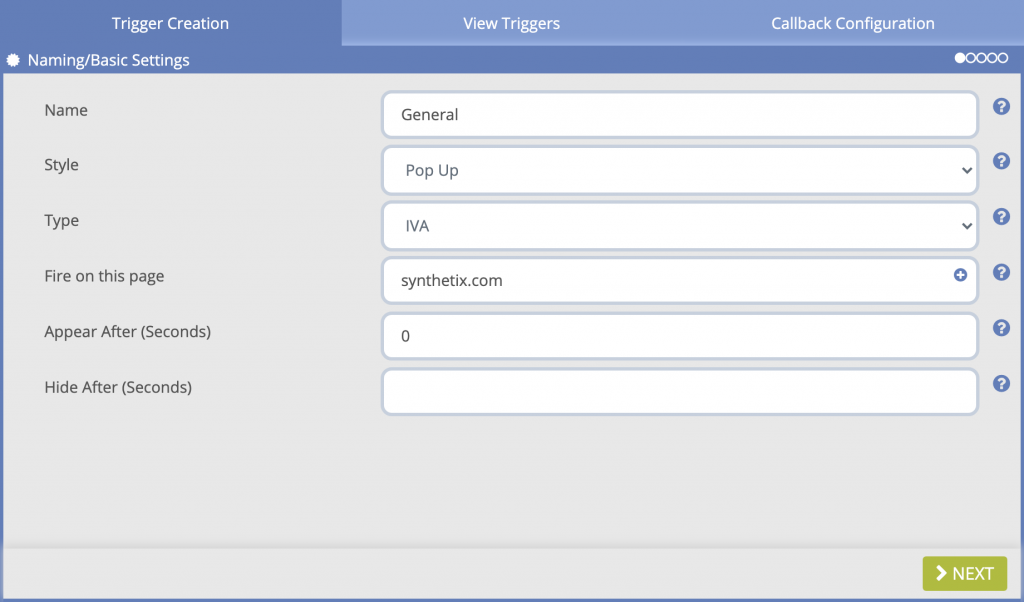
Measure Chatbot effectiveness
One of the most common mistakes that companies make when it comes to implementing chatbots, is letting them run without measuring effectiveness. You can’t manage what you don’t measure and without set goals and frequent monitoring in place, errors cannot be identified, successes cannot be replicated and failures cannot be learnt from.
To ensure chatbot effectiveness is improving over time, companies measure customer outcome metrics and customer journey metrics.
Customer outcome metrics ultimately determine how well a chatbot is doing its job. They measure to what extent queries are being fulfilled and whether any negative feedback is being received. Such feedback can help chatbots improve the articles that are delivered and the content that they contain.
Customer journey metrics help to identify any issues or opportunities that exist within the customer journey. These include:
- Click through rate (CTR)
- Average time spent on page
- Average time per session
- Pages per session
- Landing page behaviour
- Exit page behaviour
Such metrics can reveal hidden pain points or upselling opportunities that when tested and addressed can help to optimise the way a chatbot serves both customers and your company.
The Future of Chatbots
Expected to grow at a CAGR of 29.7% by 2024, the future is promising for the chatbot market. Driven by customer demand and the requirement for 24/7, instant support across industries, customer engagement and retention is the main focus for companies deploying chatbot solutions.
So how will affect companies and customer service in the future?
The Scaling Challenge
When it comes to adopting digital initiatives such as chatbot technology, Gartner reported that 33% of businesses are now in the “scaling” or “refining” stages of digital maturity – up from 17% in the previous year. Chatbot solutions are becoming mainstream, but the next challenge involves scalability – how can companies ensure large volumes of customers, with a wide range of queries are satisfied through a non-agent assisted channel? For such digital initiatives, Gartner suggests that to support customer engagement, the 3 areas of focus are:
- Volume — especially the ability to handle demand volatility and peak demand cost-effectively
- Scope — the ability to support a wide range and dynamic mix of products and services reliably
- Agility — the ability to respond to changes in consumer tastes and demands in terms of channels and features with short lag times
Scalability will prove challenging for many businesses because of the nature of chatbot technology they have chosen to implement. Basic rule-based chatbots that might appear to be ‘good value’, in the long run won’t serve companies and their requirements to scale. Because this type of chatbot does not utilse AI or have the ability to integrate and share knowledge, it becomes a siloed product outside of the customer service offering. Unable to connect to a wider technology stack, basic chatbots can’t keep up with the unpredictable rise in contact volume, nor can they learn from their interactions for constant optimisation.
Expect to see an increase in demand forAI-powered chatbots that are purpose-built to enhance CX in upcoming months. These types of chatbots can fulfil your scalability needs using NLP and Machine Learning, they can handle huge volumes of routine questions, learning from each interaction to become ‘smarter’ after each conversation. This allows chatbots to automate a wider range of diverse queries at a far quicker rate helping to scale this customer service operation.
AI And Other Smart Technologies
Gartner’s 2019 CIO Survey identified that, although 92% of respondents indicated that they either have AI on their radar, or have initiated projects, only 19% have projects currently deployed – revealing a considerable gap. With the AI market predicted to grow between 25% – 45% annually over the next three years, you can expect 2020 to jumpstart the deployment of AI-powered initiatives, particularly those in the chatbot space – helping to close the gap.
As AI becomes increasingly popular, expect other smart technologies to subsequently move along the adoption curve, including:
- NLP – Natural Language Processing
- NPU – Natural Language Understanding
- NLG – Natural Language Generation
- ML – Machine Learning
Advanced chatbot solutions will utilise such AI derivatives to deliver improved customer service, self-service, CX, lead generation and customer retention. Chatbots will adopt a more powerful AI allowing them to ‘understand’ more, deliver better results, even learn from interactions in a more effective way that will communicate the right level of professionalism depending on the individual customer.
So, expect chatbots to be ‘smarter’, performing at an optimal standard and taking on the role of a ‘virtual assistant’ that embodies the company culture. In years to come, a chatbot will no longer be a tool that can somewhat respond to your customers’ queries, but will be able to handle a range of aspects from customer service, sales, logistics and marketing – promoting CSAT and engaging in human-like conversations with customers helping free up employee time.
Preparing for The Future of Chatbots
Gartner estimates that chatbots are 90% – 100% at the early majority stage of the technology adoption curve. This means that chatbot solutions are becoming mainstream, particularly in the customer service area where many businesses have some form of chatbot.
As more of your competitors adopt chatbot technology, it will quickly become the norm and a customer expectation to offer such a tool. Failing to do so can result in customers jumping ship; switching to competitors that offer better customer service through chatbots, proving easier to work with. Customers expect the best, so it is understandable why they would avoid a company that doesn’t deliver at the very least, the same service as its competitors. But don’t offer the same service as competitors, offer more.
Stay on top of competition to provide customers with an excellent CX and customer service, this can be achieved using a sophisticated AI-powered chatbot that:
- Is built upon NLP to satisfy customer needs
- Utilises NLG to provide on-brand conversational responses
- Applies ML, learning from every interaction to improve for the future
- Is fully customisable to fit your company– from tone of voice to colour scheme
- Can integrate with other internal and customer-facing tools for knowledge sharing and depth of ‘understanding’
- Uses decision tree technology to deliver a smooth and successful customer journey
Chatbots are no longer a novelty trend but for customer service teams, they play key role in the overall offering. Chatbots can not only assist with operational efficiencies and costs, CSAT scores and customer experience, but they can compliment other contact channels brilliantly, delivering your customers the service they deserve.
If you’d like to know more about chatbot solutions and what is right for your company, you can read more here or
Final Thoughts
The deployment and implementation of knowledge management shouldn’t be complicated for any company. Assigning an experienced Knowledge Manager who can effectively execute the knowledge management process is important. But the key takeaway here is that successful knowledge management cannot be carried out without the right tools. Ensure your knowledge management software is user-friendly, low code and can integrate with self-service, chatbot, live chat and other 3rd party software– because this is what turns your knowledge into power.
Choosing a software vendor that effortlessly has knowledge management up and running is crucial. The sooner the implementation is complete, the sooner employee productivity can improve and the knowledge sharing culture can develop. Contact deflection can also begin to increase through the intelligent tools you have chosen, automating the routine and allowing agents to deal with the complex – this significantly reduces operational costs. And finally, your customers have the choice to solve their own issues or engage with a chat agent or bot – either way their experience has been enhanced attributing to customer satisfaction.




